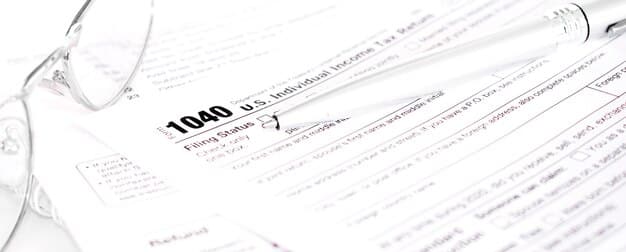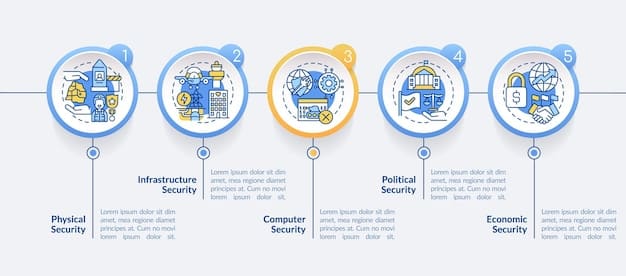Calculate & Minimize RMDs: Retirement Account Strategies for 2025

Calculating and strategically minimizing your Required Minimum Distributions (RMDs) from retirement accounts in 2025 involves understanding IRS regulations, utilizing strategies like Roth conversions, and potentially making qualified charitable distributions to optimize your tax situation.
Navigating the complexities of Required Minimum Distributions (RMDs) can be daunting, but understanding the rules and employing strategic planning can help you minimize your tax burden and preserve your retirement savings. This guide will walk you through how to calculate and minimize your required minimum distributions (RMDs) from retirement accounts in 2025, providing actionable steps and valuable insights.
Understanding Required Minimum Distributions (RMDs) in 2025
Required Minimum Distributions (RMDs) are withdrawals that the IRS requires you to take from certain retirement accounts once you reach a certain age. These rules are designed to ensure that the government eventually receives taxes on previously tax-deferred retirement savings. Understanding the specifics of RMDs is crucial for effective retirement planning.
Who is Subject to RMDs?
Generally, if you have a traditional IRA, 401(k), 403(b), or other tax-deferred retirement account, you will be subject to RMDs. Roth IRAs are an exception; they do not require withdrawals during the owner’s lifetime. However, beneficiaries of Roth IRAs are subject to RMDs.
When Do RMDs Start?
The SECURE Act 2.0 increased the age at which RMDs must begin. For those born from 1951 to 1959, the age is 73. For those born in 1960 or later, the age is 75. So, for 2025, if you turn 73, you’ll generally need to start taking RMDs.
- Age 73 (Born 1952-1959): If you reach age 73 in 2025, this is your first RMD year.
- Age 75 (Born 1960 or Later): If you were born in 1960 or later, your RMDs will begin at age 75.
- Still Working: If you’re still working and participating in your company’s 401(k), you might be able to delay RMDs from that specific account until you retire, depending on your plan’s rules.
Understanding when RMDs start is the first step in planning your distributions effectively. Ignoring these rules can lead to significant penalties, so staying informed is essential.
In conclusion, knowing who is subject to RMDs and when they start is paramount for proper retirement planning. Being aware of the age requirements and any exceptions can help you avoid penalties and manage your retirement savings effectively.
Calculating Your Required Minimum Distribution for 2025
Calculating your RMD involves a straightforward process, but it’s essential to get it right to avoid penalties. The calculation is based on dividing your prior year-end account balance by a life expectancy factor published by the IRS. Let’s break down the steps.
Step 1: Determine Your Account Balance
Your RMD is based on the value of your retirement accounts as of December 31 of the previous year. For your 2025 RMD, you’ll use the account balance as of December 31, 2024. This information can be found on your account statements.
Step 2: Find Your Life Expectancy Factor
The IRS provides a table that lists life expectancy factors based on your age. This table is used to determine how much you must withdraw each year. You can find this table in IRS Publication 590-B.

Step 3: Calculate Your RMD
To calculate your RMD, divide your prior year-end account balance by the life expectancy factor that corresponds to your age for the current year. The formula is:
RMD = Prior Year-End Account Balance / Life Expectancy Factor
- Example: Let’s say your account balance on December 31, 2024, was $500,000, and your life expectancy factor is 25.6. Your RMD would be $500,000 / 25.6 = $19,531.25.
- Multiple Accounts: If you have multiple accounts subject to RMDs, you must calculate the RMD for each account separately. However, you can withdraw the total amount from one or more accounts, rather than taking a distribution from each.
- IRS Resources: The IRS provides worksheets and tools to help you calculate your RMD accurately. Make use of these resources to ensure compliance.
Calculating your RMD is a critical step in managing your retirement distributions. Ensure you accurately calculate your RMD to avoid potential penalties, which can be substantial.
In conclusion, calculating your RMD accurately involves knowing your prior year-end balance and using the appropriate life expectancy factor. By following these steps and utilizing IRS resources, you can ensure you meet your RMD obligations and avoid penalties.
Strategies to Minimize Your RMDs in 2025
While you can’t avoid RMDs entirely, there are several strategies you can employ to minimize their impact on your tax situation. These strategies involve careful planning and understanding of tax laws and retirement account rules. Here are some effective methods.
1. Roth Conversions
Converting traditional IRA or 401(k) assets to a Roth IRA can reduce your future RMDs. Roth IRAs are not subject to RMDs during the owner’s lifetime. By converting pre-tax dollars to Roth, you pay taxes now but avoid future RMDs and potentially higher tax rates.
2. Qualified Charitable Distributions (QCDs)
If you are age 70½ or older, you can donate up to $100,000 per year directly from your IRA to a qualified charity. This is known as a Qualified Charitable Distribution (QCD). QCDs count toward your RMD but are not included in your taxable income.
3. Delaying Social Security
While not directly related to RMDs, delaying Social Security benefits can help manage your overall income and tax situation in retirement. By delaying Social Security, you can potentially reduce the need to draw as much from your retirement accounts, giving those accounts more time to grow.
- Careful Planning: Minimizing RMDs requires careful planning and consideration of your overall financial situation. Consult with a financial advisor to determine the best strategy for your needs.
- Tax Implications: Be aware of the tax implications of each strategy. Roth conversions, for example, can increase your tax liability in the year of the conversion.
- Legislative Changes: Stay informed about any legislative changes that could affect RMDs. Retirement laws are subject to change, so keeping up-to-date is essential.
Employing strategies to minimize your RMDs can help you manage your tax liability and preserve your retirement savings. Careful planning and awareness of the tax implications are key to successful implementation.
In conclusion, strategies such as Roth conversions and Qualified Charitable Distributions can be effective tools for minimizing your RMDs. Consult with a financial advisor and stay informed about legislative changes to optimize your retirement plan.
Understanding the SECURE Act 2.0 and RMDs
The SECURE Act 2.0, enacted in late 2022, brought significant changes to retirement account rules, including RMDs. Understanding these changes is crucial for planning your retirement distributions effectively. Here are the key provisions related to RMDs.
Increased RMD Age
One of the most significant changes is the increase in the age at which RMDs must begin. As mentioned earlier, the age increased to 73 starting in 2023 and will further increase to 75 in 2033. This gives retirees more time to allow their retirement accounts to grow before being required to take distributions.
Reduced Penalties
The SECURE Act 2.0 also reduced the penalty for failing to take RMDs. Previously, the penalty was 50% of the amount that should have been withdrawn. The new law reduces this penalty to 25%, and in some cases, as low as 10% if the mistake is corrected promptly.
Expanded QCDs
The SECURE Act 2.0 includes provisions that allow for a one-time QCD to charities through split-interest entities and indexes the annual QCD limit for inflation, providing more flexibility for charitable giving as part of RMD planning.

- Review Your Plan: If you have a retirement plan, review it in light of the SECURE Act 2.0. Make sure your plan reflects the new rules and take advantage of any available opportunities.
- Consult a Professional: Retirement planning can be complex, especially with changing laws. Consult with a financial advisor to ensure you’re making the best decisions for your situation.
- Stay Updated: The landscape of retirement laws and regulations is constantly evolving. Stay informed about any updates or changes that could affect your retirement planning.
The SECURE Act 2.0 has brought significant changes to RMD rules, providing more flexibility and reducing penalties. Staying informed and adjusting your retirement plan accordingly is essential for maximizing your savings.
In conclusion, understanding the provisions of the SECURE Act 2.0, such as the increased RMD age and reduced penalties, is crucial for effective retirement planning. Review your plan and consult with a professional to ensure you’re taking full advantage of these changes.
Tax Implications of RMDs
RMDs are subject to income tax, just like any other distribution from a tax-deferred retirement account. Understanding the tax implications of RMDs is essential for managing your tax liability in retirement. Here are some key considerations.
Ordinary Income Tax
RMDs are taxed as ordinary income in the year they are taken. This means they are subject to the same income tax rates as your salary or wages. The amount of your RMD that is taxable will depend on the tax bracket you fall into.
Impact on Tax Bracket
Taking RMDs can push you into a higher tax bracket, especially if you have other sources of income. This can increase your overall tax liability and reduce the amount of money you have available for spending in retirement. Plan your distributions carefully to manage your tax bracket effectively.
State Taxes
In addition to federal income tax, some states also tax RMDs. Check the laws in your state to understand whether your RMDs will be subject to state income tax and plan accordingly.
- Tax Planning: Work with a tax advisor or financial planner to develop a tax-efficient strategy for taking RMDs. This can help you minimize your tax liability and maximize your retirement income.
- Estimated Taxes: If you don’t have enough taxes withheld from your RMDs, you may need to pay estimated taxes throughout the year to avoid penalties.
- Withholding Options: You can choose to have taxes withheld from your RMDs, just like you do with a paycheck. This can help you avoid surprises when you file your taxes.
Understanding the tax implications of RMDs is crucial for managing your finances in retirement. Be aware of how RMDs can impact your tax bracket and plan accordingly to minimize your tax liability.
In conclusion, RMDs are subject to ordinary income tax and can impact your tax bracket. Develop a tax-efficient strategy and consider your withholding options to manage your tax liability effectively.
Planning Ahead for 2025 RMDs
Planning for RMDs should be an ongoing process, not just something you think about as you approach retirement age. The earlier you start planning, the more options you will have to minimize your tax liability and maximize your retirement income. Here are some tips for planning ahead.
Start Early
Begin planning for RMDs well before you reach the age at which they are required. This will give you more time to consider your options and make informed decisions. Consider your overall financial situation, including your other sources of income, your expenses, and your tax situation.
Consult a Financial Advisor
Work with a financial advisor to develop a comprehensive retirement plan that takes RMDs into account. A financial advisor can help you assess your financial situation, understand your options, and develop a strategy that meets your needs and goals.
Stay Informed
Keep up-to-date with the latest retirement laws and regulations, including any changes to RMD rules. This will help you make informed decisions and avoid potential penalties. The IRS and other reputable sources provide valuable information about retirement planning.
- Regular Review: Review your retirement plan regularly to ensure it still meets your needs and goals. Make adjustments as necessary to account for changes in your financial situation or retirement laws.
- Diversification: Diversify your retirement savings across different types of accounts and investments. This can help you manage risk and maximize your returns.
- Long-Term Perspective: Take a long-term perspective when planning for RMDs. Consider how your decisions today will impact your retirement income and tax liability in the future.
Planning ahead for RMDs is essential for maximizing your retirement income and minimizing your tax liability. Start early, consult a financial advisor, and stay informed about the latest laws and regulations.
In conclusion, planning for RMDs should be an ongoing process that starts well before you reach retirement age. Consult a financial advisor and stay informed to make the best decisions for your financial future.
| Key Point | Brief Description |
|---|---|
| 📅 RMD Start Age | Age 73 for those born 1952-1959; Age 75 for those born 1960+. |
| 🧮 Calculation | Divide prior year-end balance by IRS life expectancy factor. |
| 🔄 Roth Conversions | Converting to Roth IRAs can decrease future RMDs. |
| 🎁 QCDs | Qualified Charitable Distributions count towards RMD but aren’t taxable. |
Frequently Asked Questions (FAQs)
▼
If you fail to take your RMD, the IRS can impose a penalty. The SECURE Act 2.0 reduced the penalty to 25% of the RMD amount, or even 10% if you correct the mistake promptly.
▼
Yes, you can take more than your RMD. However, any amount you withdraw will still be subject to income tax. There are no penalties for taking more than the required amount.
▼
Yes, Roth 401(k) accounts are subject to RMDs, unlike Roth IRAs. However, you can avoid RMDs by rolling your Roth 401(k) into a Roth IRA before the RMD age.
▼
You can find your life expectancy factor in IRS Publication 590-B. This publication contains tables that list life expectancy factors based on your age, used to calculate your RMD.
▼
No, you must be age 70½ or older to make Qualified Charitable Distributions (QCDs) from your IRA. These distributions count towards your RMD and are not included in your taxable income.
Conclusion
Understanding and planning for Required Minimum Distributions is a critical aspect of retirement planning. By knowing how to calculate your RMDs, employing strategies to minimize them, and staying informed about legislative changes, you can effectively manage your retirement income and tax liability. Consult with a financial advisor to create a comprehensive plan tailored to your specific needs and goals.





